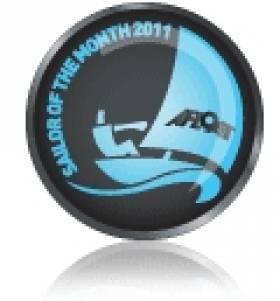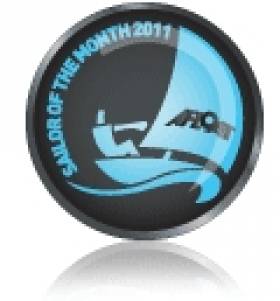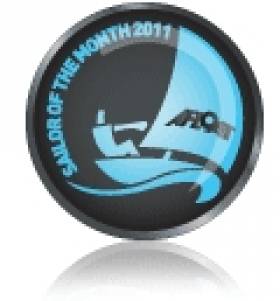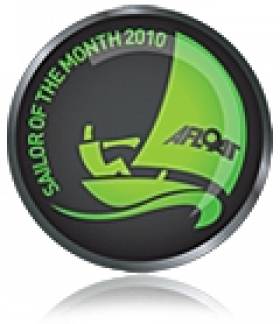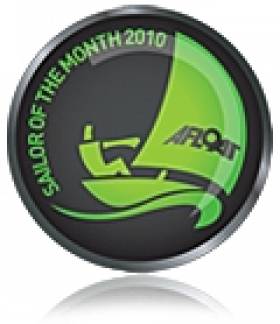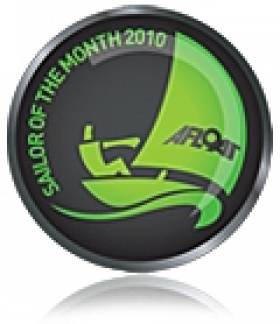Displaying items by tag: Sailor of the Month
Pat Kelly is Afloat's Sailor of the Month for November
#SAILOR OF THE MONTH – Pat Kelly of Rush Sailing Club is the Afloat.ie/Irish Independent "Sailor of the Month" for November after his J/109 Storm - crewed by fellow-Fingallions - was celebrated as the Irish Cruiser Racer Association "Boat of the Year" at the ICRA annual general meeting in Dun Laoghaire at the weekend.
The sailors of north Fingal are on a roll these days. Back in September, Matt Davis of Skerries won our monthly award after his Sigma 400 Raging Bull retained the Irish Sea offshore championship. And another Skerries sailor, windsurfer Oisin van Gelderen, continues to be Ireland's fastest man afloat, his current official best speed being 44.23 knots.
Now it's the turn of Rush to top the podium. Not that Rush is new to successful sailing. Once upon a time, it was the top port on the east coast of Ireland for smugglers who veered into privateering and occasionally even piracy. To succeed in any of these activities, they needed fast ships and able skippers, and captains like Luke Ryan and James Mathews gave Rush its formidable sailing reputation.

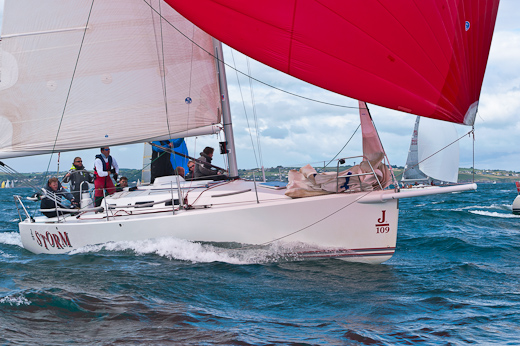
Storm was made ICRA Boat of the year last weekend and this Saturday her skipper Pat Kelly becomes Sailor of the month for November. Photos: Bob Bateman
Highlight of Pat Kelly's season with Storm was his outright class win in the ICRA Nationals at Crosshaven. Five wins in six races is the sort of performance that would get the Luke Ryan/James Mathews seal of approval. Storm was also regularly in the frame in many other major events, and had frequent success in regattas and club racing with a dedication to sailing that does her skipper and crew proud.
Pat kept his previous 30-footer in the tide-riven anchorage at Rogerstown off Rush SC's attractive south-facing clubhouse, one of the few south-facing sailing clubhouses in the entire country. However, with the bigger boat it was necessary to find a berth at Howth, and in fact Storm sails as a joint HYC/RSC entry. But the club in Howth wouldn't begrudge this success to their smaller neighbours to the north. And with their own marina in fine shape (it hosts next year's ICRA Nationals in late May), they'd be the first to agree that the only thing holding back north Fingal sailing from even greater achievements is the lack of sheltered and conveniently accessible pontoon berthing on the entire coast between Malahide and Carlingford Lough.
More from WM Nixon in the Irish Independent here
Racing Round Up: Lasers, E Boats, Puppeteers,DBSC, VDLR, Royal Cork, Cove and Sailor of the Month
In Cork Harbour 'Mid-Summer Madness' regatta attracted 40 Boats. We have the photos. There was a Fun Time for Cruisers at Cove Sailing Club's 'At Home' Regatta.
Galway's Martin Breen is June's Sailor of the Month and the Waterford Tall Ships Parade of Sail Photos are here.
Reasons to be cheerful? You bet. Click here to read how Dublin Bay sailors celebrate these wins.
Martin Breen is June's Sailor of the Month
It's the fourth time that a Galway boat has won the Dingle race, giving Galway Bay SC unrivalled status, as the race has only been sailed a total of ten times. It was launched as a biennial event in 1993, and back in the day it was Donal Morrissey et al who started the process with two wins with the GK 34 Joggernaut. Then Eamon Conneely took both line honours and the handicap win with his first TP52 Patches, and now Martin Breen has done the business with his recently-acquired Reflex 38, which raced to Dingle under the moniker of Galway Harbour.
A former army captain, Breen's progress up the ladder of sailing achievement has been steady. He first made his mark with a successful Sigma 33, then there was more west coast sailing silverware taken with a Corby 33, and now he has the first Irish-based Reflex 38.
A hands-on skipper, for the race to Dingle he beefed up his usual ship's complement of family and friends with Galway's own Aodhan Fitzgerald, who in turn brought in Neil Spain and Johnny Murphy who had been on the Fitzgerald crew which won the round Ireland race.
Galway Harbour sailed a perfect first stage down the Irish Sea to lead everything on the water at the Tuskar Rock. On the long drag race to the Fastnet in a backing and strengthening southerly, only the Open 40 Pride of Dalkey-Fuji got ahead of the Galway boat, which managed to hang in despite blowing out a spinnaker and getting a tear in the mainsail.
By the time they reached the Fastnet, with the wind still veering they were already beating, and it was a slug into the Atlantic up to the next turn at the Skellig rock. The final stage into Dingle almost became a spinnaker reach, which would have been a problem as they'd blown out their reaching spinnaker on the south coast, but the wind stayed nor'west just long enough to get them into port and a superb win with a little bit of luck and a lot of talent
Colm Newport is Afloat's Sailor of the Month for April
Colm Newport was the Master of the sail training brigantine Asgard II when she started taking in water from an unexplained leak in the small hours of September 11th 2008 off the coast of France.
Like all Asgard's commanders during the ship's remarkable 27 year career which took her all over the world, he had a special affection for Asgard II, a small square rigger which punched way above her weight in the company of the world's largest tall ships.
But this was no occasion for sentimentality, and the sadness could wait until later. In a seamanlike manner, Newport analysed the reality of the situation, and calmly ensured that his full-rime crew and the ship's complement of young trainees clearly realized that the order to take up stations to abandon ship was for real – it wasn't simply an unexpected safety drill.
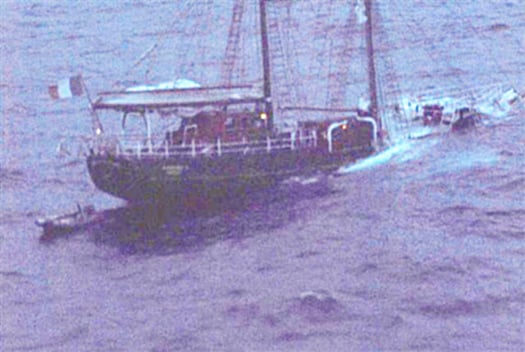
Asgard II sinks by the bow on September 11 2008 off the coast of France. Photo: Courtesy French Search and Rescue Service
To the credit of all on board, the transfer to the liferafts took place in a calm atmosphere, and as the beloved ship's final hour afloat arrived, Captain Newport gave the order to move away from the vicinity of the vessel to avoid any danger of the liferafts being dragged down by the rigging.
No-one was injured, few had any time even to be frightened, and thanks to the captain and crew's professional skill, the horror of drownings to wipe out Ireland's sail training programme was avoided.
Asgard II being a government-owned ship, the follow-through was inevitably slow. And as the national economic crash was getting up its full head of steam, the priorities of a national sail training programme open to all young people slipped right down the scale, until the Department of Defence quietly wound up Coiste an Asgard, and the insurance money for the ship went into the rapidly shrinking national coffers.
But the spirit lives on, and the newly established Sail Training Ireland – a voluntary body open to membership and all sorts of support – has been set up by several who were involved in Coiste an Asgard. It is officially recognized as the successor to the Asgard programme, and is already strengthened with bursaries from the global body Sail Training International.
In time, we may have a new square rigger, and she really will be the people's ship. But the fact that it can be anticipated with hope and enthusiasm is in large part due to the calm efficiency of Colm Newport and his crew on the morning of September 11th 2008.
Latest Asgard II Stories
Latest Tall Ships News from Ireland
Kearney is January Sailor of the Month
As we learned in 2001 when the Mirror Worlds were staged in Ireland, although Peter Bayly of Lough Derg may have won that time round, the strongest national challenge was by the Australians. They've developed what was originally envisaged as a useful general purpose family sailing dinghy into a very potent racing machine.
Thus it was quite an achievement for the 25-year-old Kearney to win in the Oz home waters. But for the Cultra sailor it was extra special, as he is the first Mirror helmsman to win the worlds twice, having taken the title back in 2005, racing in Sweden.
The Mirror being a small boat, an athlete like Ross Kearney has to select his crew from junior sailors. In 2005 it was young Adam McCullough, this time round it was Max Odell, and he and his skipper showed their serious intent towards the Worlds with a very clear win in the Mirror Europeans in Sligo last September.
On the strength of his proven record in the class, Kearney works as a sailmaker and designer with leading English firm Pinner & Bax. They're based in Northampton, about as far from the sea as it's possible to be in England, and a bit of a culture shock for a young sailor who is accustomed to getting his sea sailing just yards from home. But with a second world title now logged, we can expect to see more of Ross Kearney on the sea, and on bigger boats than a Mirror dinghy.
Kearney wins Mirror Title Story HERE.
Ian Bath is the Irish Independent/Afloat.ie Sailor of the Month for December
Who will be Irish Sailor of the Year 2010?
At home and abroad, Irish sailors once again delivered an impressive range of results in 2010.
Click on the month to the left to review our top sailors by month. And vote for them in our online poll (left)
As in previous years, Afloat magazine is asking the public to decide who should be crowned Ireland’s Sailor of the Year for 2010.
The overall national award will be presented to the person who, in the judge’s opinion, achieved the most notable results in, or made the most significant contribution to, watersports during 2010. Now you can log on to Afloat.ie and help select the shortlist from the last 12 months’ top performers by clicking on your sailor in the left hand column of the home page. The boating public gets to nominate their top three through the online poll, Afloat.ie gets a vote too and the Sailor of the Year judges decide the final winner.
Cast your vote by midnight February 18, 2011. The awards are administered and judged by Afloat magazine, the Irish Independent and the Irish Sailing Association.
The judges decision is final and no correspondence will be entered into.
Thanks for your interest!

Nicholas O'Leary is Afloat's November Sailor of the Month
Nicholas "Nin" O'Leary of Cork has re-written the Irish sailing records, and he's only 24. The new All Ireland Champion Helm is clear winner of the Afloat.ie/Irish Independent "Sailor of the Month" award for November after a nail-biting finale in difficult conditions off Kinsale, making it three-in-a-row for this junior skipper who was winning major titles with impressive scorelines well before he was out of his teens.
The wind was drawing from the east for the 20th November shootout in the ISA's SailFleet of J/80s. But the challenge lay in the fact that, after a week of strong winds up to gale force, a massive swell was rolling in past the Bulman Buoy to provide sea conditions which were out of sync with the strength of the breeze.
Yet the three top Royal Cork helms showed they were up to the challenge. In fact, it was Neil Kenefick, in the championship through being tops in the ICRA series in 2010, who best got to grips with the racing in the early stages, posting two wins with Anthony O'Leary second in the first race, while son Nicholas was second in the next one.
But the junior O'Leary moved nearer to retaining the title by winning the third, though his father was right there with a second, while James Espey from the Lasers posted a third. However, Kenefick was in touch with a fourth, but that became his discount as he nailed a couple of thirds in the two concluding races.
Going into the fifth and final race, the three Crosshaven helms were neck-and-neck on points, but O'Leary Junior put it neatly away by slicing in ahead of his father, with Kenefick third. The Corkmen were out on their own, as next in line was Puppeteer 22 Champion Garret May, but he concluded with 18 net points, while Neil Kenefick was on 8, Anthony O'Leary on 7, and Nicholas O'Leary the supreme champion on 6. And making a bit of history while he was at it - the first three-in-a-row in the All Ireland's 64 years.
John Sheehy is October's Sailor of the Month
John Sheehy of Dun Laoghaire is the latest Afloat.ie/Irish Independent "Sailor of the Month" after his convincing recovery to retain his title as National Match Racing Champion in Kinsale on October 24th.
Recovery and retention became the theme of a hotly-fought series, as Sheehy had seemed to be off form on the opening day, far from overnight leader, in the doldrums way back in fourth. Things were still rocky on the second day as they battled on all fronts to stay in contention after taking a beating from Ben Duncan of Howth, who seemed on track to be the new champion.
But Sheehy and his crew sailed off on their own for a brief onboard motivation session. He had a crew of all the talents in Darragh O'Connor, Paddy Kirwan and Marty O'Leary and they returned to the fray fired up on all cylinders to go into the final series with eight wins, while Duncan had nine.
However, by this stage there was no stopping the John Sheehy onslaught. He clinched two more excellent starts and retained the lead despite ferocious pressure in both matches from Ben Duncan, who was clear second overall, while Sam Hunt was third, narrowly ahead of Prof O'Connell.
Sailor of the Month September 2010 - OISIN VAN GELDEREN
Oisin van Gelderen of Skerries is the Afloat.ie/Irish Independent "Sailor of the Month" for September after his sensational windsurfer speed runs on the famous Marine Lake at West Kirby near Liverpool on September 15th. (SCROLL DOWN FOR VIDEO OF THE RECORD RUN)
Zooming along in 30—35 knot breezes, and using the specialised GPS analytical systems which have been developed for this extremely advanced form of sailing, van Gelderen (40) recorded a fastest speed burst of 47.17 knots. And although his average from his five best runs was down at 43.19 knots, it is still a new Irish record.
It is almost impossible for anyone outside windsurfing to imagine what it's like to experience these speeds on a board. The current unlimited world speed sailing record is 51.36 knots, established a year ago by Alain Thebault and his crew on the 60ft French trimaran Hydroptere, which skims across the water on hydrofoils once a basic speed (quite high in itself) is achieved.
Because of the hydrofoils, all hulls of the boat are clear of the water. And although the spray can fly across like a fusillade of bullets, you are travelling in luxury by comparison with a lone windsurfer battling the elements.
Going hyper-fast, water doesn't seem like water any more. It's more like concrete. Yet this kind of speed provides heaps of adrenalin, and then some. The sailing was so good that Van Gelderen would have kept going on into the night, but the danger of crashing into the West Kirby walls in the dark was very real.
While the Hydroptere speeds were the result of crew and technical team joint efforts, although Oisin van Gelderen was using the best of windsurfer technology, there is an intensely personal element in his feat which no other form of sailing can match, and we salute his achievement.


























